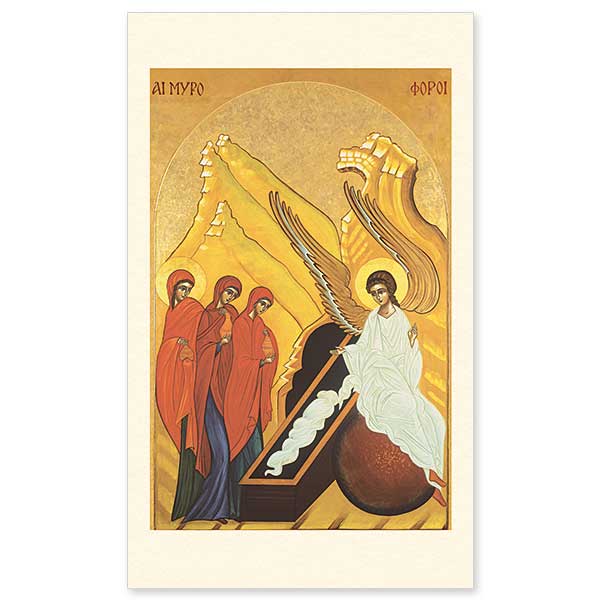

| Cards as shown (No Imprinting) | |||||
| Item Number | Description | Price Each | Quantity | Total | Action |
|---|---|---|---|---|---|
| PCM521 | Package of 25 icon holy cards |
$8.50 |
package |
$8.50 | |
| Item Number | Select Imprinting option: | Price Each | Quantity | Total | Action |
|---|---|---|---|---|---|
| Not Selected |
|
|
cards 30 piece minimum. |
In this icon, Mary Magdalene, Mary the mother of Jesus, and Salome arrive at the tomb, carrying spices to anoint the body of Jesus. They encounter an angel who tells them to be unafraid, Jesus is risen. This icon, whose design dates from third century, is a beautiful reminder of the Easter miracle. It is also known as the “Myrrh bearers."
Icon holy cards are 3" x 5", a convenient size for use as gifts or bookmarks. The backs are blank except for a faint colophon at the bottom, leaving plenty of room for custom imprinting with your own message.
Near the end of Markís Gospel in Chapter 16 we find the account of the discovery of Christís resurrection. Three women, named as Mary Magdalene, Mary the mother of James (the Less) and Joses, and Salome (presumably identified in Matthew 27:55 as the mother of James the Greater and John) arrive at the tomb at sunrise on the first day of the week, carrying spices to anoint the body of Jesus. They find the stone rolled back, the tomb empty, and a young man dressed in white who tells them to be unafraid, Jesus is risen. This ancient icon of the Gospel story dates from the third century and is named in Greek the myrophorai or Myrrhbearers, myrrh being the principle spice used to anoint the dead in biblical times. Our version is a twentieth century writing by Sister Marie-Paul that closely follows the traditional outline.
The tomb is drawn in inverse perspective, parts close up appearing smaller than those further away. This visual device is common in icons as a way to draw the viewer into the scene. The linen cloth that wrapped Jesusí body lies before us in mute but eloquent evidence of the resurrection miracle. The angel sits upon the rolled-back stone that served as the door of the sepulchre. The Greek writing at the top of the icon can be translated as "the myrrh bearers," or "the anointing ones."
The angel and only one of the three women have their heads surrounded by golden halos. These symbols of sanctity are reserved in icons for those persons known to be saints, officially named as such by the church. Angels as messengers from God are all sanctified, and of the three women, only Saint Mary Magdalene is so named. The only other identifying feature among the three women is Mary Magdaleneís barely visible long, curly hair, traditionally included to represent her beauty. As in most traditional icons, all the faces look very similar. Their eyes are large and soulful, noses long and straight in conformity with Byzantine notions of nobility, and mouths small and closed indicating spiritual contemplation. The angelís head is uncovered, but is otherwise represented as gender-neutral.
The miracle of the empty tomb is depicted for us in a simple, graceful composition, full of flowing lines and sharp contrasts. We see a scene of solemn contemplation of this mystery which is beyond human understanding. There were no human witnesses to the resurrection itself, but the angel has rolled back the stone to show us proof of the event. The icon background is gold leaf used in iconography to symbolize divine "uncreated" light. The metal is used in this way because of its value, permanence, and ability to reflect light in a manner so different from pigment. The fanciful mountains are not intended to show realistically the surroundings of the tomb but instead represent the spiritual ascent we all make through faith as we come to believe in the significance of the empty tomb.